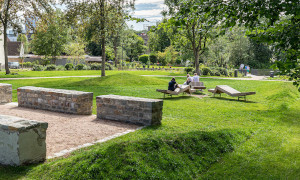Bund Deutscher Landschaftsarchitekten (bdla Berlin/Brandenburg) calls for expanded functions of green spaces in the city Thinking more about green and open spaces on an aesthetic, technical and social level
- As "green infrastructure", urban green space should be on an equal footing with other urban infrastructures.
- Creating, maintaining and cleaning urban green space between inter-institutional community task and regulatory concerns
Press release, July 7, 2016
Cemetery space or shoreline strips - in many cities, green spaces are increasingly under pressure: population figures in Berlin, Munich and other German metropolises continue to grow, and so green spaces within the city and even on its periphery are often seen as the residential development sites of tomorrow. At a conference in Berlin on 1 July, around 150 landscape architects and urban planners called for a rethink: green spaces and nature in cities should not be leftovers for urban development, but on the contrary should set the pace. In the future, the urban green must be seen as green infrastructure, which is just as important for urban planning as the grey infrastructure (transport, energy, etc.) or the social infrastructure (schools, day-care centres, etc.).
Equality demanded
The chances of equality in the canon of infrastructures are obviously not bad. Because: "Despite the pressure of use, green spaces and nature in the city are currently being taken more seriously in municipal and also federal politics than they have been for decades," says Eike Richter from the Berlin/Brandenburg regional association of the Association of German Landscape Architects (bdla). "The political objective at federal level is clear. We need green in the city, and we want to link nature conservation more closely with urban development," says Hagen Eyink, head of the "Green in the City" department at the Federal Ministry for the Environment, Nature Conservation, Building and Nuclear Safety (BMUB).
More than just a new term
Green infrastructure - the association is obviously not just concerned with a new terminology that is intended to make the voice of urban greenery heard more clearly in a world that is saturated with technology. It is about using green and open spaces to fulfil new functions for the city. Landscape architect Antje Backhaus cites protection from weather extremes as an example. "Due to climate change, we will increasingly have to deal with storms of the century, for which our cities are not prepared," says Backhaus. Her work includes Copenhagen, where green and open spaces have recently taken on what's called heavy rainfall management: Schoolyards, parks, private backyards, and even public streetscapes have been holistically planned and redesigned to better absorb and target large amounts of rain.
"In Copenhagen, they speak proudly of their rainforests." In keeping with the technological terminology, such green infrastructure also makes greater use of technology, such as new underground drainage systems. At the same time, the spaces are designed to serve aesthetic and social functions. "They must always have amenity quality as well. In good weather, they are attractive recreational or play areas," Backhaus adds.
Extended living room
An important point - because green spaces are the green living room for many city dwellers today: "We are observing that private life is increasingly shifting outdoors in the summer," says Winfried Becker, head of street cleaning at Berlin's city cleaning service (BSR). Parks and green spaces are not only used for Sunday strolls, but also as places to celebrate and meet people. In addition, there are the well-known functions: "Urban greenery provides a better climate and serves biodiversity. And it is indispensable for human health," says Eike Richter of the bdla. He also sees an opportunity for sensory experiences: Wild growing adventure spaces, for example, could provide children with an experience of nature that is otherwise often lacking in the city. Green infrastructure - ideally considered together with the blue, i.e. water bodies - is part of the public provision of public services, according to the tenor.
Inter-institutional joint task
But: green spaces need to be actively maintained. In Berlin, several projects are currently testing how the tasks of maintenance on the one hand and waste disposal and cleaning on the other can be optimally organized. "In twelve parks and one forest district, we are testing the division of tasks. We take over the cleaning, the landscape gardeners can devote themselves to the demanding horticultural green care. So everyone does what he or she is a professional at," says Becker from BSR.
In addition to the public sector and public companies such as BSR, private citizens could also be more involved in maintenance. Rüdiger Dittmar, Head of the Office for Urban Green Spaces and Waters of the City of Leipzig: "Civic involvement in urban green spaces is very important to the municipalities, but we have made the experience that the municipal maintenance costs can only be reduced slightly through this, if at all." However, this is not the goal of civic engagement; rather, it is important that the citizenry identifies with its urban green.
"Green infrastructure must be thought beyond the boundaries of institutions," demands Eike Richter from the bdla. Other participants, on the other hand, see a problem when partial tasks are removed from public sovereignty - especially from a regulatory perspective. There are also limits to civic involvement - if professionally managed care is required for large or complex areas.
One conclusion of the conference: Compromises are needed in the distribution of tasks between the various players - in order to seize the opportunity and finally put the issue of green infrastructure on the political agenda of policymakers. "We have always endeavoured to network green structures," sums up Eyink from BMUB. "Now we are challenged to network institutions. Green infrastructure is a joint task."
The Association of German Landscape Architects bdla has 1,300 members nationwide and has existed for over 100 years. The Berlin Brandenburg regional group of the bdla is concerned with landscape architecture in high-density inner-city areas through to sparsely populated rural areas.
- Latitude: 0
- Longitude: 0


